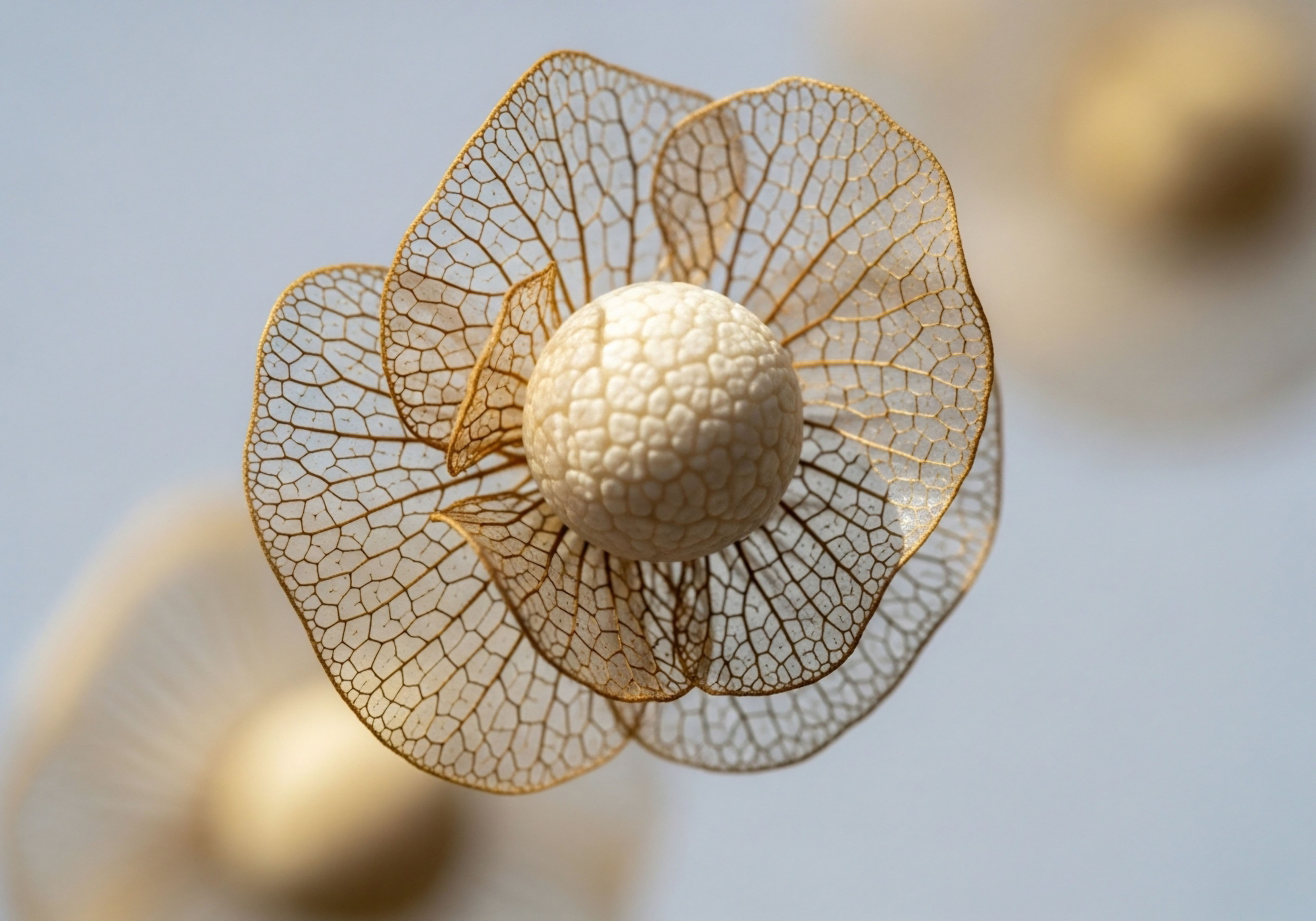

Fundamentals
The feeling of being out of sync is a deeply personal one. It manifests as a quiet drag on your energy, a subtle clouding of your thoughts, or a sense of being a stranger in your own body. These experiences are valid, and they often have a clear biological address.
Your body operates as an intricate, responsive system, constantly interpreting and adapting to the world around it. The language it uses for this internal dialogue is hormonal. Understanding this language is the first step toward reclaiming your vitality. We can learn to communicate with this system, and one of the most ancient and powerful dialects we have at our disposal is temperature.
At the heart of your physiology lies the endocrine system, a sophisticated network of glands that produce and secrete hormones. Think of it as the body’s internal wireless communication network. Hormones are the data packets, the chemical messengers that travel through your bloodstream to instruct distant cells and organs on how to behave.
They regulate your metabolism, your mood, your sleep cycles, your stress response, and your reproductive health. This system is designed for balance, a state of dynamic equilibrium known as homeostasis. When a message is sent, a feedback mechanism ensures the system knows when to stop. It is an elegant, self-regulating architecture that maintains your internal stability.
The body’s endocrine system is a self-regulating network that uses hormones as chemical messengers to maintain internal balance.
Introducing deliberate, controlled stressors can be a method to strengthen this system. This concept is called hormesis. It is the principle that a beneficial effect can result from exposure to low doses of an agent that is otherwise toxic or lethal when given at high doses.
Exercise is a classic example; you intentionally stress your muscles to make them stronger. Thermal protocols, such as sauna and cold water immersion, operate on this very principle. They are intentional, manageable stressors that you apply to your body, not to cause harm, but to provoke a powerful, adaptive response from your endocrine and nervous systems. By exposing your body to these ancient signals of heat and cold, you are prompting it to recalibrate and reinforce its own regulatory pathways.

The Language of Heat and Cold
Your body is exquisitely sensitive to temperature. This sensitivity is a primal survival mechanism. Heat and cold are potent environmental signals that trigger immediate and profound physiological adjustments. When you step into a sauna, your body perceives a challenge. Your heart rate increases, your blood vessels dilate, and you begin to sweat to cool down.
Conversely, when you immerse yourself in cold water, your body initiates a different set of survival protocols. Blood vessels constrict, pulling blood toward your core to protect vital organs, and your metabolism fires up to generate heat. These are surface-level reactions. Beneath them, a complex and beneficial hormonal cascade is set in motion. These thermal sessions are conversations with your biology, using a language it has understood for millennia.

The Master Regulators
The entire endocrine orchestra is conducted by two key structures in the brain ∞ the hypothalamus and the pituitary gland. The hypothalamus acts as the command center, constantly monitoring your internal state. It receives signals about everything from your body temperature and energy levels to the amount of light your eyes perceive.
Based on this data, it sends instructions to the pituitary gland. The pituitary, in turn, releases its own hormones that travel to the other endocrine glands ∞ the thyroid, the adrenals, and the gonads (testes in men, ovaries in women) ∞ telling them what to do. This top-down command structure is known as an axis.
For instance, the Hypothalamic-Pituitary-Adrenal (HPA) axis governs your stress response, while the Hypothalamic-Pituitary-Gonadal (HPG) axis controls reproductive health. Thermal protocols directly influence these master regulators, sending powerful signals up the chain of command that can help reset the entire system.


Intermediate
Understanding that temperature can influence hormonal health is the first step. The next is to comprehend the specific mechanisms at play. Deliberate heat and cold exposure are not passive therapies; they are active interventions that trigger distinct and measurable physiological responses.
Each protocol offers a unique set of hormonal benefits, and when used in combination, they can create a synergistic effect that enhances the body’s resilience and promotes endocrine equilibrium. This is where we move from the ‘what’ to the ‘how’ ∞ how exactly does a session in a sauna or a plunge into cold water translate into better hormonal function?

The Physiology of Heat Exposure
When you expose your body to the intense heat of a sauna, you are initiating a process called hyperthermia. This controlled increase in body temperature activates a suite of adaptive responses designed to protect cells from heat-related stress and damage. This process is far more than a simple detoxification through sweat; it is a deep cellular and endocrine event.

Heat Shock Proteins and Cellular Resilience
One of the most significant effects of heat stress is the robust production of Heat Shock Proteins (HSPs). These are specialized proteins that act as intracellular chaperones. Their primary role is to identify, refold, and repair other proteins that have been damaged or denatured by stress.
By enhancing the production of HSPs, regular sauna use effectively bolsters your cells’ internal quality control systems. This cellular housekeeping has profound implications for hormonal health, as the receptors that hormones bind to are themselves proteins. Healthy, correctly folded receptors are essential for proper hormone signaling.
Damaged receptors can lead to a form of hormone resistance, where the hormone is present in the bloodstream but fails to exert its effect on the cell. Therefore, by improving the integrity of these protein structures, HSPs ensure that your body can properly receive and respond to hormonal messages.

Growth Hormone and Endorphin Release
Sauna use has also been shown to be a potent stimulator of Growth Hormone (GH) release from the pituitary gland. GH plays a vital role in cellular regeneration, tissue repair, and maintaining lean muscle mass. Its release is often pulsatile, occurring in bursts, and sauna sessions can significantly amplify these bursts.
This increase in GH contributes to improved recovery from physical activity and supports the maintenance of a healthy metabolic rate. Simultaneously, the intense heat triggers the release of endorphins, the body’s natural opioids. These neurochemicals are responsible for the feeling of mild euphoria or tranquility often experienced after a sauna session. Their release also plays a role in modulating the stress response, providing a powerful counterbalance to the primary stress hormone, cortisol.

The Physiology of Cold Water Immersion
Submerging your body in cold water triggers an immediate and powerful sympathetic nervous system response. This is the “fight or flight” system. While chronic activation of this system is detrimental, acute and controlled activation through cold exposure acts as a form of exercise for your nervous system, leading to beneficial long-term adaptations.

The Norepinephrine Surge
The most dramatic hormonal response to a cold plunge is a massive release of norepinephrine into the bloodstream. Norepinephrine functions as both a hormone and a neurotransmitter. Its release leads to a state of heightened alertness, focus, and vigilance.
This surge can have a significant impact on mood, often producing an antidepressant effect that can last for hours after the plunge. From an endocrine perspective, norepinephrine is crucial for metabolic function. It stimulates the thyroid gland, a key regulator of your body’s metabolic rate, potentially aiding those with sluggish metabolism. It also plays a role in the conversion of white adipose tissue (the body’s primary fat storage) into more metabolically active brown adipose tissue, which can increase calorie expenditure.

Insulin Sensitivity and Cortisol Modulation
Regular cold exposure has been demonstrated to improve insulin sensitivity. Insulin is the hormone responsible for shuttling glucose from the bloodstream into cells to be used for energy. When cells become resistant to insulin’s effects, the pancreas must produce more of it to compensate, leading to high blood sugar and a host of metabolic problems, including Polycystic Ovarian Syndrome (PCOS) and type 2 diabetes.
Cold exposure enhances glucose uptake by muscle cells, even without the presence of insulin, thereby reducing the overall burden on the pancreas and improving the body’s ability to manage blood sugar. While the initial shock of cold water causes a brief spike in cortisol, consistent practice trains the body to mount a less dramatic stress response over time. This adaptive process can lead to lower overall baseline cortisol levels, which is a cornerstone of hormonal balance.
Controlled cold exposure can trigger a significant release of norepinephrine, enhancing focus and metabolic rate.

Contrast Therapy the Synergistic Approach
Combining heat and cold exposure, a practice known as contrast therapy, offers a unique method for training the autonomic nervous system. By rapidly switching between the vasodilation of the sauna and the vasoconstriction of the cold plunge, you are essentially performing vascular gymnastics.
This process enhances circulation and trains your body to shift more efficiently between the parasympathetic (rest and digest) and sympathetic (fight or flight) states. This increased adaptability is crucial for hormonal stability, as it helps to balance the output of stress hormones from the HPA axis and reproductive hormones from the HPG axis.
The following table provides a comparative overview of the primary hormonal effects of each modality:
| Hormonal Effect | Heat Therapy (Sauna) | Cold Therapy (Cold Plunge) |
|---|---|---|
| Stress Response |
Promotes endorphin release, which can buffer the effects of cortisol. Over time, may help regulate the HPA axis. |
Causes an acute spike in cortisol and norepinephrine, but regular use can lower baseline cortisol levels and improve stress resilience. |
| Metabolic Hormones |
May improve insulin sensitivity through improved circulation and reduction of inflammatory mediators. |
Significantly enhances insulin sensitivity and glucose uptake. Stimulates thyroid function via norepinephrine release. |
| Growth and Repair |
Potent stimulator of Growth Hormone (GH) release. Increases production of Heat Shock Proteins (HSPs) for cellular repair. |
Reduces inflammation, which can aid in recovery. The hormonal impact on growth is less direct than that of heat therapy. |
| Neurotransmitters |
Increases release of endorphins, promoting relaxation and improved mood. |
Causes a massive and sustained release of norepinephrine and dopamine, enhancing focus, alertness, and mood. |


Academic
A sophisticated examination of thermal protocols on hormonal health requires moving beyond generalized benefits and into the precise biochemical and neuroendocrine pathways being modulated. The conversation must be centered on the body’s primary regulatory loops, chiefly the Hypothalamic-Pituitary-Adrenal (HPA) axis and its intricate relationship with the Hypothalamic-Pituitary-Gonadal (HPG) axis.
Thermal stressors do not act on single hormones in isolation; they provide a systemic input that creates a ripple effect across interconnected physiological systems. The academic inquiry, therefore, is one of systems biology ∞ how does a targeted, external stimulus like temperature perturb the homeostatic balance in a way that elicits a net-positive adaptation in endocrine function?

Modulation of the Hypothalamic Pituitary Adrenal Axis
The HPA axis is the body’s central stress response system. Its activation begins in the hypothalamus with the secretion of Corticotropin-Releasing Hormone (CRH). CRH signals the anterior pituitary gland to release Adrenocorticotropic Hormone (ACTH), which then travels to the adrenal cortex and stimulates the synthesis and release of glucocorticoids, most notably cortisol.
While essential for acute survival, chronic activation of the HPA axis and the resultant elevation of cortisol is profoundly disruptive to systemic health, contributing to metabolic dysregulation, immune suppression, and disruption of gonadal function.

The Cortisol Resetting Effect
Thermal protocols introduce an acute, controlled stressor that allows for the conditioning of the HPA axis. A 2021 study published in the journal Endocrine involving repeated exposure to sauna followed by cold water immersion in young men demonstrated a statistically significant decrease in serum cortisol levels. This finding is of paramount importance.
The reduction in circulating cortisol suggests that the combined thermal stress, when applied consistently, has a net-inhibitory or down-regulating effect on the HPA axis. This is not merely a transient feeling of relaxation; it is a measurable biochemical shift toward a less stressed, more parasympathetically dominant state.
The mechanism is likely twofold. First, the intense endorphin release triggered by heat acts as a natural opioid, which can have an inhibitory effect on the HPA axis at the level of the hypothalamus.
Second, the repeated, acute activation of the sympathetic nervous system by the cold plunge may lead to a long-term increase in the tonic inhibition of the HPA axis, making it less reactive to other life stressors. A well-regulated HPA axis is the foundation upon which all other hormonal balance is built.

Interplay with the Hypothalamic Pituitary Gonadal Axis
The HPG axis governs reproductive function and the production of steroid hormones like testosterone and estrogen. Its activity begins with the pulsatile release of Gonadotropin-Releasing Hormone (GnRH) from the hypothalamus, which stimulates the pituitary to release Luteinizing Hormone (LH) and Follicle-Stimulating Hormone (FSH).
In men, LH acts on the Leydig cells of the testes to produce testosterone. In women, LH and FSH orchestrate the complex hormonal fluctuations of the menstrual cycle. The HPA and HPG axes are deeply intertwined; high levels of cortisol can suppress the release of GnRH, thereby inhibiting the entire reproductive cascade.

What Is the Effect of Thermal Stress on Testosterone?
The effect of thermal stress on testosterone is an area of active investigation with some complexities in the data. Some studies have suggested that acute sauna exposure can lead to a transient increase in LH and, subsequently, a temporary surge in testosterone.
This may be due to the heat-induced increase in metabolic activity and circulation to the gonads. However, the aforementioned 2021 study found no statistically significant change in testosterone levels following a protocol of repeated sauna and cold immersion sessions. This does not necessarily represent a contradiction.
It highlights the difference between acute, transient effects and long-term, stable adaptations. While a single session might cause a temporary fluctuation, the more profound and lasting benefit may come from the systemic improvements driven by HPA axis regulation.
By lowering chronic cortisol levels, thermal protocols reduce the suppressive effect of stress on the HPG axis, creating a more favorable internal environment for optimal testosterone production, even if the protocols themselves do not directly and acutely boost the hormone in every instance.
Lowering chronic cortisol through thermal therapy creates a more favorable environment for the entire endocrine system to function optimally.

Mitochondrial Health and Steroidogenesis
A deeper layer of analysis reveals the impact of thermal stress at the subcellular level, specifically on mitochondrial function. Mitochondria are the powerhouses of the cell, responsible for generating ATP, the body’s primary energy currency. Their function is also indispensable for steroidogenesis ∞ the metabolic pathway that synthesizes steroid hormones from cholesterol.
This process is energetically demanding and relies on a healthy and dense population of mitochondria within the cells of the adrenal glands and gonads. Research has indicated that mild thermal stressors can induce mitochondrial biogenesis, the process of creating new mitochondria.
The activation of pathways involving HSPs and other cellular stress responses can signal the cell to improve its energy production capacity. By enhancing mitochondrial density and efficiency, thermal protocols may directly support the raw manufacturing capacity of the glands responsible for producing cortisol, testosterone, progesterone, and other critical hormones. This provides a foundational, mechanistic link between an external stimulus like temperature and the body’s intrinsic ability to maintain a robust hormonal profile.
The following table details specific hormonal responses to thermal stimuli, drawing from available research to provide a more granular view.
| Hormone/Neurotransmitter | Response to Heat (Sauna) | Response to Cold (Immersion) | Underlying Mechanism and Significance |
|---|---|---|---|
| Cortisol |
May cause a slight, acute increase, but regular use contributes to lower baseline levels, particularly when combined with cold. |
Causes a sharp, acute increase during immersion, but regular practice leads to a blunted response and lower overall baseline levels. |
This demonstrates a classic hormetic adaptation of the HPA axis, leading to improved stress resilience. |
| Norepinephrine |
Minimal direct effect. |
Causes a significant, sustained increase (200-500% or more). |
Enhances mood, focus, and metabolic rate. A key mechanism for the antidepressant and cognitive benefits of cold therapy. |
| Growth Hormone (GH) |
Potent stimulus for release, with some studies showing significant increases after repeated sessions. |
No significant direct effect noted in most studies. |
Supports tissue repair, lean mass maintenance, and overall metabolic health. |
| Prolactin |
May see a slight increase, possibly related to heat stress and fluid balance regulation. |
Studies generally show no significant change or a slight decrease. |
The lack of a major change indicates these protocols do not unduly stress the pituitary in a way that would disrupt this hormone, which is important for reproductive health. |
| Testosterone |
Some evidence for acute, transient increases, possibly linked to LH release. |
Most studies show no statistically significant long-term change. The primary benefit is likely indirect via cortisol reduction. |
The main value for testosterone appears to be in creating a healthier systemic environment by lowering stress, rather than direct stimulation. |

Are There Gender Specific Considerations for Thermal Protocols?
The majority of early research on thermal stress focused on male participants. However, the female endocrine system, with its cyclical nature, presents unique considerations. The hormonal fluctuations of the menstrual cycle, perimenopause, and menopause mean that a woman’s response to thermal stress can vary depending on her life stage and even the time of the month.
- Follicular Phase ∞ During the first half of the menstrual cycle, estrogen is rising and body temperature is generally lower. Women may find they are more resilient to both heat and cold stress during this time.
- Luteal Phase ∞ In the second half, after ovulation, progesterone rises, leading to a slight increase in basal body temperature. Some women may experience greater sensitivity to heat during this phase and may need to adjust the duration or temperature of sauna sessions.
- Perimenopause and Menopause ∞ For women experiencing vasomotor symptoms like hot flashes, the intentional use of sauna may seem counterintuitive. However, by improving the body’s thermoregulatory capacity, regular sauna use can, for some, lead to a reduction in the frequency and intensity of hot flashes. Cold plunges can be particularly beneficial during this transition for their mood-stabilizing effects and for combating the inflammation that can increase during menopause.
The key is an individualized approach. Women must be encouraged to listen to their bodies and adjust protocols accordingly. The goal is to apply a manageable, adaptive stress, not to overwhelm a system that is already in a state of flux. For instance, a woman in her luteal phase might opt for a shorter sauna session or a slightly less frigid cold plunge, still reaping the benefits without pushing her body into an excessive stress state.

References
- Jedema, I. et al. “The effect of repeated whole-body cold-water immersion on inflammatory and hormonal responses in healthy men.” European Journal of Applied Physiology, vol. 121, no. 8, 2021, pp. 2287-2297.
- Leppäluoto, J. et al. “Endocrine effects of repeated sauna bathing.” Acta Physiologica Scandinavica, vol. 128, no. 3, 1986, pp. 467-470.
- Pilch, Wanda, et al. “Effect of a single Finnish sauna session on the hormonal profile and cortisol-to-DHEA-S ratio in young men.” Journal of Human Kinetics, vol. 39, 2013, pp. 127-137.
- Zychowska, M. et al. “Endocrine Effects of Repeated Hot Thermal Stress and Cold Water Immersion in Young Adult Men.” International Journal of Environmental Research and Public Health, vol. 18, no. 8, 2021, p. 4034.
- Kukkonen-Harjula, K. and K. Kauppinen. “Health effects and risks of sauna bathing.” International Journal of Circumpolar Health, vol. 65, no. 3, 2006, pp. 195-205.
- Brenner, I. K. M. et al. “The effect of heat exposure on plasma catecholamine and corticosterone responses to restraint stress in rats.” Neuroscience Letters, vol. 257, no. 1, 1998, pp. 29-32.
- Tipton, M. J. et al. “Cold water immersion ∞ kill or cure?” Experimental Physiology, vol. 102, no. 11, 2017, pp. 1335-1355.
- Scoon, G. S. et al. “Effect of post-exercise sauna bathing on the endurance performance of competitive male runners.” Journal of Science and Medicine in Sport, vol. 10, no. 4, 2007, pp. 259-262.

Reflection
The information presented here is a map, not the territory itself. It details the biological pathways and hormonal responses, offering a scientific framework for understanding how your body communicates with its environment. Yet, the most profound insights will come from your own lived experience.
How does your body feel after the deep warmth of a sauna? What is the quality of your mental state in the hours following a cold plunge? This journey is about cultivating a deeper awareness of your own unique physiology.
The data and the studies provide the language, but you are the one who must learn to speak it with your own body. The goal is to move from passively experiencing symptoms to actively engaging with the systems that govern your health. This knowledge is a tool, and with it, you can begin to deliberately shape the inputs you provide your body, guiding it back toward its innate state of balance and vitality.

Glossary

endocrine system

stress response

hormesis

cold water immersion

body temperature

pituitary gland

cold exposure

heat shock proteins

growth hormone

metabolic rate

nervous system

norepinephrine

cold plunge

insulin sensitivity

cortisol levels

contrast therapy

hpa axis

hpg axis

external stimulus like temperature

thermal stress

menstrual cycle

steroidogenesis

mitochondrial biogenesis




